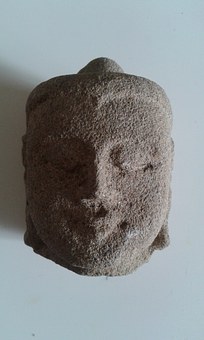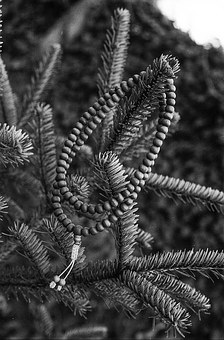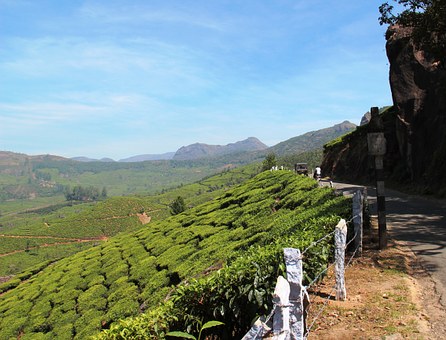Mallorca Travel: A Visit to the Castell de Bellver and a Drive East to Inca and Alcudia

After five great days in my temporary home in the Western Bay of Palma it was now
time to relocate and have a closer look at the eastern side of island. I needed to check out today and move into my next apartment in Port d'Alcudia. I packed my suitcase and left the Terranova Aparthotel complex which had been a great location to explore the western and northern side of the island.Taking the coastal highway eastwards from Palmanova through the more upscale coastal developments of Portals Nous and Illetes west of the capital, I exited just west of the harbour area of Palma de Mallorca and drove through a pleasant neighbourhood and past the verdant flanks of Bellver Hill to the parking lot of the Castle of Bellver, one of Palma's main historic sights.
Several large tour buses had already unloaded dozens of school children on this gorgeous Thursday morning. I strolled up to the entrance of the castle and paid the 4 Euro admission fee to gain access to this famous round medieval castle. Built in the early 1300s for King James II of Aragon, it is now one of Palma's most popular tourist attractions.
Once I entered into the courtyard of the castle, the circular design became really apparent. Two tiers of arcades held up with Gothic pillars on the second floor and round arches on the main floor surround the castle's inner courtyard which is anchored by three massive circular towers. The centre of the castle is highlighted by a well which still holds water at the bottom.

Most of the doors in the castle were closed, but one door on the main floor was open and led me into the Museum of the City of Palma which chronicles the history of the city dating back to pre-historic times (the Pre-Talayotic Culture), featuring earthenware that was produced in 1600 before Christ. The Romans conquered the island in 123 BC and ushered in the Romanization of the Balearic Island. The Moors ruled the island between 902 and 1229 AD and were responsible for great advances in agriculture, including terraced irrigation systems, many of which are still visible today. Palma's medieval history and more recent developments are also illustrated in this museum.
I then made my up to the second floor and from there onto the top floor of the castle which provides a phenomenal 360 degree view of the surrounding landscapes. With its location on a hilltop, the Castell de Bellver has one of the most prominent locations in the entire city of Palma and offers a fabulous view towards the downtown, the harbour and the famous La Seu Cathedral.
One floor down there is another museum that features a very large collection of Roman-era statues, jewellery and gravestones. Next to these exhibits is a large medieval-looking room with oversized pots and cauldrons. The ceiling of this room is blackened, and although there were no explanations, I assumed that this might have been a kitchen with an open hearth in earlier times. Bellver Castle is a must-see destination in Palma, and offers a great opportunity to visit an extremely well-preserved circular Gothic castle that is almost 800 years old.
I got back into my car and started heading east on the C713 highway to the town of Inca, which is located in the interior of the island just a bit south of the majestic Tramuntana Mountains. Inca, the third-largest town on the island of Mallorca, is an industrial town and the centre of the island's leather manufacturing industry.
Every Thursday there is a street market in the city, and I was lucky to arrive on market day as the city was bustling with activity. The market stretches for kilometers from one square to another. A wide range of merchandise includes fruits and vegetables as well as a large variety of clothing and houseware items. I just could not resist and had to buy a quart of freshly picked Spanish cherries. A Latin American Indian band was playing on the main square, and thousands of locals were strolling slowly to do their shopping. In Europe, people still do a lot of their shopping in weekly outdoor markets.
Jewellery was also on sale, and I ended up purchasing a few necklaces made of Mallorcan pearls, manufactured by the Perlas Majorica factory in Manacor. Mallorcan pearls are actually glass beads that are covered with multiple layers of a fish scale and resin mixture resin. The final product is hard to distinguish from real pearls. The necklaces I bought would make a great souvenir for my friends back in Canada.
I headed back on the highway to continue driving northeast towards Alcudia, a historic town at the southern end of the Bay of Pollena. I stopped at a local gas station and the friendly residents explained to me how to get to Port d'Alcudia where I would be spending the next 3 days, residing at the Eden Aparthotel Alcudia.
Interestingly enough, after spending so many days in and near the Tramuntana Mountain range, Port d'Alcudia with its flat topography, straight main street and modern architecture, reminded me more of Florida than of the Spanish islands. Finally, I had reached my hotel, parked my vehicle right out front and obtained the keys at reception. The hotel was decent enough, but the unit was very small, a very compact bachelor apartment with a mini-kitchen.
This self-catering unit was perfect for me in allowing me to look after my own food preparation needs in the next few days. The only drawback was the northeast facing location which had me facing out into a tree above the parking lot without any view or sunshine whatsoever. This was a huge contrast to the great location of my last apartment unit in Palmanova where I had had a perfect view over the Mediterranean from my large terrace.
But never mind, the accommodations were fine and I was not planning to spend much time in the unit anyway. I headed downstairs into the lobby and out into the attractive back garden which had a great swimming pool and some grassy rest areas. Families with small children were relaxing by the pool and enjoying a sunny afternoon.
I walked through the gardens and out the back towards the sea. Steps away from the hotel was the Mediterranean, more specifically the Bay of Alcudia, a very wide bay that is capped off by a chain of medium-height mountains on the northern and southern side. I walked a little bit further north in search of a downtown area with cafes and restaurants, but I was unable to locate an older downtown core. Port d'Alcudia indeed seemed to be much more a town of relatively recent tourist developments, rather than a historically grown town.
In search of a more historic place, I hopped into my car and drove a few kilometers north to Alcudia, a truly historic town of 15,000 people that is surrounded by 14th century walls. The town was already settled by the Phoenicians, and after the Roman conquest, the town of Pollentia, located just outside of today's city walls, actually became the capital of Mallorca from the 2nd century AD onwards. In 456 AD the town was finally destroyed by the Vandals, but around 800, the Moors built a fortress here which they called "Al-Kudia", which means "the hill". Any history buff will truly enjoy this city.
I parked my car outside the fortification walls and entered the town on a narrow cobble-stoned street. Every thing was quiet, hardly a person could be seen until I reached the main square with the Casa Consistorial, the city hall, which dates back to 1523 AD. Turning left I walked up the town's main street which features a large number of shops, boutiques, cafs and restaurants.
Many of the stores were closed as it was siesta time. In Spain and other southern countries you always have to watch out for the mid-day rest period that is intended to shelter the locals from the scorching noon-time sun. Here, siesta appeared to be scheduled form 1 to 4 pm, and some of the stores had indeed closed their doors.
One of the main sights in Alcudia is the Gothic church of Sant Jaume which dates back to the 13th century. It was closed this afternoon so I was unable to have a look at the interior, so I continued my stroll and happened to come across the old medieval fortification walls, a portion of which has been made accessible to visitors through stairs and a walkway on top of the walls. The stairs were fairly steep to get up, but the walk on top of the fortification walls provided me with a great view of the orange tiled rooftops of the town.

I then drove through the eastern part of town into a residential area next to the water where the wind was absolutely howling. Continuing my drive further north along the Bay of Pollena I stopped to admire dozens of kite-surfers that were plying the waters, some of them lifting off high in the air and flying good stretches before they would come crashing back down on the water. The wide Bay of Pollena is one of Mallorca's most popular destinations for kite-surfers.
I spent the evening in Port de Pollena, a scenic town at the north end of the Bay of Pollena, which has a great waterfront promenade and long sandy beach lined by palm trees. As the sun started to set I made a quick stop at Cala San Vicen, a pretty village on the north coast just a few kilometres from Pollena before I headed back to my hotel where I enjoyed a home-made dinner on the balcony of my unit. After watching some French Open tennis on television, I went to bed early to get ready for a long day of explorations tomorrow.
Mallorca Travel: A Visit to the Castell de Bellver and a Drive East to Inca and Alcudia
By: Susanne Pacher Mallorca Travel: Arrival at the Luxurious Finca Son Pont and Dinner in Banyalbufar Mallorca Travel: Exploring Eastern Mallorca: Arta, Capdepera and Cala Rajada Mallorca Travel: Exploring Northern Mallorca: Alaro, Bunyola, Valdemossa and Folklore at La Granja Mallorca Travel: Exploring Port de Sóller and Palmanova Mallorca Travel: Exploring Puig de Maria, Pollenca and Cap de Formentor Mallorca Travel – A Drive through the Tramuntana Mountains, Country Luxury at Finca Ca's Sant and a Great Evening in Sóller Mallorca Travel: Sant Elm, Sa Dragonera, Galilea and an Evening Stroll in Palma de Mallorca Mallorca Travel: The West Coast and the Capital of Palma de Mallorca CLIMATE CHANGE - TINJIANG TO CANCUN A Strategy to Learn French Easily Methods for Learning French Buying the Best Trailers for a Better Travel Experience Ideals for creating Halloween Art